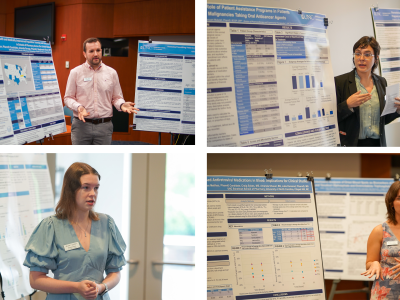March 16, 2015

- Glaucoma patients are more than twice as likely to be adherent to their medication regimen if their health-provider tells them how to use their eye drops.
- Patients received instruction on using their eye drops in only 14 percent of visits.
- Provider instruction was the only communication factor in the study that improved adherence. Physicians discussing subjects such as the disease, adherence, side effects, and effectiveness of treatment with the patient did not.
Patients with glaucoma are much better at taking their medication as prescribed when a health-care provider tells them how. However, that rarely happens, according to a recent study from the University of North Carolina at Chapel Hill.
Glaucoma is the second-leading cause of blindness in the United States and the leading cause of preventable blindness in African Americans and Latinos. Researchers from UNC Eshelman School of Pharmacy observed 279 glaucoma patients interacting with fifteen physicians and found that the patients usually did not get instructions on how to properly use their glaucoma eye drops.
Only 14 percent of glaucoma patient visits included directions from the physician on how to properly administer prescription eye drops. Patients who were taught how to use their drops were more than twice as likely to use them as prescribed than patients who received no instructions.
“Physicians talked about glaucoma — adherence, side effects, and how well the medications are working — and we thought all of those conversations would influence adherence rates for patients,” says contributing author Delesha Carpenter, PhD, MSPH.
“That wasn’t the case.”
The research team found that the only doctor-patient communication factor strongly associated with increased adherence was whether the provider educated the patient about how to administer their eye drops. Adherence is the extent to which patients take medication as prescribed by their health-care provider.
The results of the study were published in Ophthalmology, the journal of the American Academy of Ophthalmology,
A Leading Cause of Blindness

“The finding of our study is important because it means that doctors and pharmacists should take the time to explain to patients how to use their eye drops,” says Betsy Sleath, PhD, lead author of the study.
Lack of instruction is strongly associated with poor adherence, which means patients are taking their medication correctly less than 80 percent of the time. A prior study testing the use of two different sizes of eye-drop bottles found that only 22 and 31 percent of patients correctly administered their antiglaucoma eye drops. An estimated 1.5 million Americans have glaucoma, approximately 120,000 of whom are blind because of the disease. Between 9 and 12 percent of all blindness in the United States can be attributed to glaucoma.
Glaucoma is a disease with no symptoms where fluid inside the eye does not drain properly causing pressure inside the eye to increase. The increased pressure can damage the optic nerve.

“The take-away message to glaucoma patients is that if you are unsure how to administer the drops, make sure to ask a doctor or pharmacist to show you,” Sleath says. “By doing this, you will be able to take a more active role in preventing your own blindness.”
The Study
The UNC study observed fifteen physicians interacting with 279 glaucoma patients to gauge whether communication by the doctor affected medicine adherence.
The majority of study participants, 81.7 percent, had been taking glaucoma medication before taking part in the study. Their ages ranged from 21 to 93 with the average age being almost 66. A majority of the patients seen were female at 59.1 percent, and 35.5 percent of the patients were black.
The researchers looked at seven factors when analyzing doctor-patient interaction:
- Whether the patient asked a question about glaucoma
- Whether the patient asked a question about glaucoma medication
- Whether the provider discussed glaucoma with the patient
- Whether the provider discussed the purpose of the medications with the patient
- Whether the provider discussed the importance of adherence with the patient
- Whether the provider discussed a medication’s side effects with the patient
- Whether the provider discussed how to administer the glaucoma medication with the patient
After participating patients visited a physician, they were given a container with their eye drop medication. The container had a cap that electronically recorded the date and times it was opened so researchers could measure adherence.
The Patients
After patients saw their doctors, they were given a questionnaire to determine demographic information and the level of their belief or confidence in their ability to take their glaucoma medications, a quality known as self-efficacy.
Patients reporting high levels of self-efficacy are much more likely to adhere to medication, Sleath says.
Patient expectations also played a role in adherence. Those who believed that visiting a physician and taking medication would help their glaucoma were much more likely to adhere to the medication than those who reported lower expectations.
Researchers also found that black patients, patients who are newly prescribed glaucoma medication, and patients taking multiple glaucoma medications were significantly less likely to optimally adhere to their medication.
“If patients don’t take their medications correctly then developing newer and better drugs could be a waste of resources. This study highlights the need for maximizing the communication skills of doctors, their staff and pharmacists during patient education,” says senior author Alan Robin, MD.
Study Authors
- Betsy Sleath, PhD, is the George H. Cocolas Distinguished Professor at the UNC Eshelman School of Pharmacy and chair of the School’s Division of Pharmaceutical Outcomes and Policy.
- Susan Blalock, PhD, is a professor in and vice chair of the Division of Pharmaceutical Outcomes and Policy at the UNC Eshelman School of Pharmacy.
- Delesha Carpenter, PhD, MSPH, is an assistant professor in the Division of Pharmaceutical Outcomes and Policy at the UNC Eshelman School of Pharmacy.
- Robyn Sayner, PharmD, was a postdoctoral fellow in the Division of Pharmaceutical Outcomes and Policy at the UNC Eshelman School of Pharmacy.
- Kelly Muir, MD, is a physician at Duke University School of Medicine and Durham VA Medical Center.
- Catherine Slota is a graduate student in the Division of Pharmaceutical Outcomes and Policy at the UNC Eshelman School of Pharmacy.
- Scott Lawrence, MD, is an assistant professor at UNC School of Medicine’s Kittner Eye Center.
- Annette Giangiacomo, MD, is an assistant professor at the Emory University School of Medicine.
- Mary Elizabeth Hartnett, MD, is a professor at the John A. Moran Eye Center at the University of Utah.
- Gail Tudor, PhD, is director of institutional research at Husson University.
- Jason Goldsmith, MD, is a physician at the John A. Moran Eye Center at the University of Utah.
- Alan Robin, MD, is an associate professor at the University of Maryland-Baltimore, University of Michigan, and the Johns Hopkins University School of Medicine and the Bloomberg School of Public Health.
This study was supported by the National Eye Institute (grant no.: EY018400) and the National Center for Research Resources (grant no.: 1UL1TR001111), and the National Institutes of Health (grant nos.: EY015130 and EY017011 [M.E.H.]).
Latest News

RASP poster presentations capture student research

Delesha Carpenter promoted to full professor


